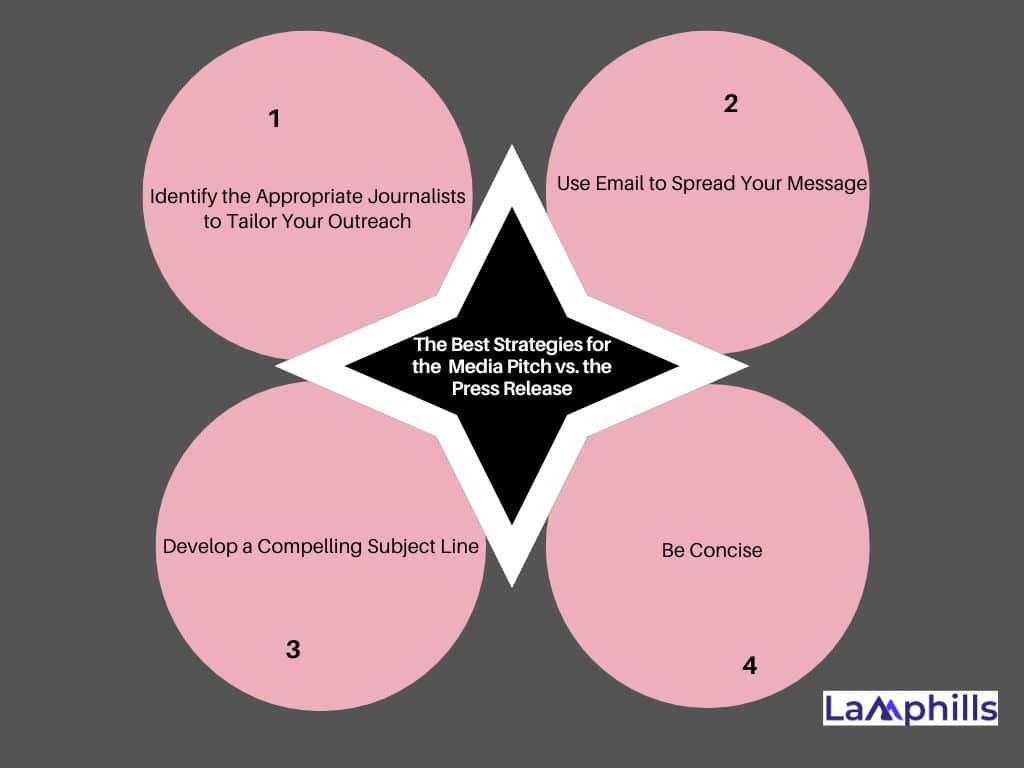In an expanding economy thanks to technological advancement, people seek to publicize their brands or announce the launch of a new business. But you may be thinking that this is an excellent moment to make a press release, a media pitch, or maybe both regarding the activities at your company. What’s the ideal approach to providing information to journalists such that it resonates and reaches your target audience, so you can avoid the stress? Press release vs. media pitch. Let’s talk about the distinction between a press release and a media pitch before we move on.
An attempt to persuade journalists to accept your press release as the basis for media coverage is known as a media pitch. Media pitches clarify why the story is significant and worthy of attention, while press releases just summarize what happened. Direct and succinct language makes for a compelling media pitch.
Key Points
- A press release tells exactly what happened or will happen shortly, whereas a media pitch explains why a story angle or event is significant and warrants coverage.
- The purpose of press releases, which typically consist of one or two pages and cover the five Ws—who, what, when, where, and why—is to enable journalists to reuse the information provided to a larger audience with no need for follow-up.
- To convince journalists, editors, producers, or other media professionals to cover a certain story, issue, or event, one can use a media pitch, which can be sent via email, direct message, or phone call.
- Considering their purpose or final objective the simplest method to distinguish between a press release and a media pitch is to consider their aim or ultimate end goal. Pitch lengths should be brief, while press releases should normally be longer to include all pertinent information about your announcement.
What’s Meant by a Media Pitch?
To convince journalists, editors, producers, or other media professionals to cover a certain story, issue, or event, one can use a media pitch, which can be sent via email, direct message, or phone call. PR pros, businesses, or people utilize it as a tool to get media attention and raise awareness of a specific topic.
Your tailored approach to journalists to persuade them to write about or notice your topic is known as a pitch. Typically, this is sent as a brief email, but on occasion, if the reporter asks for or needs additional information, a press release or other resources are sent.
Pitch lengths should be brief, while press releases should normally be longer to include all pertinent information about an announcement. Pitches are unique because they allow you to demonstrate to a journalist that you are knowledgeable about the topics they cover and why your concept for a story would be a good fit for their audience.
They ought to be eye-catching as well. Pitches are crucial since they are your first opportunity to impress a journalist and have the power to increase or decrease your chances of being covered.
The Best Time to Submit a Media Pitch to the Reporter
The following is an example of what I use when I want to reach out to a journalist with a media pitch:
- If you have a story idea intended for a certain journalist and can articulate why this pitch is intended especially for them and their audience, that is when a media pitch can be sent to the reporter.
Read Also: How to Write a Media Pitch with Practical Examples & Templates
What’s Meant by a Press Release?
When a newsworthy announcement is made, a press release is a written or recorded message intended for journalists. They’re usually emailed to assignment editors at newspapers, magazines, radio stations, and television stations, or sent via email using a press release distribution service. Usually formatted according to formal guidelines, a press release, also called a news release, is a written announcement of something noteworthy.
When I was sending my press release to the journalist, I had all my press release components to avoid giving the journalist work or my work being rejected. The following are components of press releases:
- The headline.
- The subheadline.
- Dateline.
- The key information is in the lead sentence.
- The body, which provides additional information about the news, is usually written in the newswriter’s inverted pyramid format.
- Also, the citations from representatives.
- A boilerplate for a customer or business.
- Details of who to contact.
The purpose of press releases, which typically consist of one or two pages and cover the five Ws—who, what, when, where, and why—is to enable journalists to reuse the information provided to a larger audience with no need for follow-up.
Press releases are frequently crafted with a large number of journalists covering a particular topic or beat in mind. They are typically distributed and uploaded publicly for journalists to view through the use of a “wire service” such as Business Wire. A lot of public relations specialists also send news releases to a group of journalists using their personal email.
The benefits of distributing press releases are controversial, but there’s no doubt that a well-thought-out and timely press release can provide your company or client with excellent media coverage.
When Is the Best Time to Forward a Press Release to a Reporter?
The following are a few instances I used when sending a press release to a journalist:
- The first is if you want to inform a lot of journalists about significant news.
- Secondly, the information in your story needs more justification or specifics than what is typically included in a media pitch.
- When a reporter accepts a story concept and then asks for further details,
- Another is when you wish to add a proper press release to the website or online newsroom of your business.
Read Also: BEST TIME TO SEND A PRESS RELEASE ACCORDING TO YOUR AUDIENCE
The Press Release vs. the Media Pitch, What Distinguishes Them?
In the media pitch vs. the press release, there are two separate types of public relations (PR) communication tools that have various functions and formats with the media. A media pitch is a compelling letter sent to a journalist or blogger asking them to write a story, cover an event, etc. That’s how it differs from a press release. In contrast, a press release is an objective report about a noteworthy event or promotion that is written in a particular format. Your media pitch could occasionally consist of a brief statement that points readers to a news release for further details.
In some circumstances, pitches and press releases work together to generate media attention for a single topic, much like two parts of a whole. Press releases are formal, complete statements that contain all the information required to produce a story. However, media pitches are brief, personalized messages intended to catch a journalist’s attention and persuade them to cover a story. Press releases are meant to make formal announcements and offer information on the record. However, media pitches, on the other hand, are typically used to promote stories that might not be covered.
In other situations, though, you might be pitching a story idea to a reporter without having a complete press release written to see if they will take it. This allows you to better tailor that piece to the reporter’s style and the topics that interest the reporter’s readers the most. You can choose and organize each most efficiently. The following about the press release vs. the media pitch is how I compare the difference between them below:
Media Pitch
As I drafted my media pitch, I had all the details of what a media pitch should have. The following are the details I completed when drafting my media pitch:
#1. Objective
A media pitch is a brief, tailored message addressed to a reporter or media organization to spark their curiosity about a story and persuade them to cover it. You have to know your objective as you draft your media pitch.
#2. Structure
It usually consists of a summary of the story’s salient features and an explanation of why the readership of the journalist would find it interesting. A call to action, such as requesting an interview or providing further details, could also be included.
#3. Target Audience
Media pitches frequently show that the sender has done their homework and is aware of the recipient’s beat and audience because they are customized for that particular journalist or media outlet. The main reason why I was drafting my media pitch was to boost my brand, and in doing this, I needed the audience. If you are drafting your media pitch, make sure it is for your target audience.
#4. Timing
To give the journalist time to think about the topic and respond, pitches are frequently sent out ahead of an event or news announcement. I had my timing when drafting my media pitch, as the saying goes, “Time is money.”. However, if you are drafting your media pitch, you should work with time.
#5. There Is Some Interest in Media Pitches
Because you made their job easier, journalists will be interested in a well-written press release that has all the information and some excellent quotes! A media pitch can be thought of as more like a resume’s cover letter. I made my media pitch easy and eye-catching for the journalist, which made the journalist interested in my content. If you want the blogger or journalist to choose your story, make sure you include enough information to pique their interest.
Press Release
When I was drafting my press release, I had all the details of what a press release should have. The following are the details I completed when drafting my press release:
#1. Purpose
A press release is a definitive statement that is issued to the media to provide precise and accurate information. They also make important announcements or address any critical situation. When I was drafting my press release, I had a purpose, which was to reach the target audience for my brand. If you are drafting your press release, you should have a purpose.
#2. Structure
A press release typically follows a standardized format that incorporates. For example, a headline, a dateline, an introduction, body paragraphs, quotes, and contact information. It is a more comprehensive and authoritative way of communicating news than a media pitch. In my press release draft, my content was in order. However, if you want to get to it, you have to follow the standard structure.
#3. Distribution
Press releases are an effective way to reach a broad audience. They are typically distributed through various channels, such as newswires or press release distribution services. In addition, they are being sent directly to specific journalists or media outlets. You have to create your press release in an effective way to reach a larger audience.
#4. Content
Journalists receive all the essential information, along with quotes and multimedia assets, to craft a compelling story. When sending your content to the journalist, make sure it has the essential information needed.
#5. The Whole Story Is Covered in Press Releases
The who, what, when, where, and why of your news are all included in a press release. But a media pitch is only a sneak peek. It gives out very little information about your new service, product demonstration, or any innovative venture you are working on for your company. A strong press release may be released without modification, but a media pitch cannot.
The Best Strategies for the Media pitch vs. the press release
Knowing the best strategies (the media pitch vs. the press release) provides distinct benefits depending on the situation. However, you can have their proper locations in your public relations toolkit. Regardless of the one you use, the following are a few best practices I followed when drafting them:
#1. Identify the appropriate journalists to tailor your outreach
When creating my pitch or press release, I prepare my content by finding a good reporter and my target audience. A great pitch or press release begins with a little preparation. Before you send an email, extensively study the reporters you intend to contact to guarantee you’ve discovered the correct people for your story idea. Reading past pieces by a journalist can help you grasp their point of view, writing style, and communication style with their audience.
#2. Use email to spread your message
Email remains the most popular communication channel among journalists. When I was drafting my pitch, I took my time to see that there was no error in the pitch. Sending a pitch or press release by email allows you to take a little more time carefully writing your material, proofreading, and customizing your message before sending it.
#3. Develop a compelling subject line
Before I drafted my first press release, I was nervous to avoid rejection by the journalist. So I took my time to read books and do some online research on how to draft the press release. However, I drafted the press release and checked to see that there were no errors, and there were none. Also, I made the subject line eye-catching to attract the journalist, and then I sent it to the reporter’s email. In no time, the journalist read my press release and was happy. It was stress-free, which also made me happy because my content was published for the audience to see. If the reporter does not open your email, your press release or pitch will be ineffective.
Read Also: 7 Proven PR Writing Secrets for Grabbing Media Attention Every Time
Also, I worked for a company with a degree in computer science, but I took a course certified in journalism. One day, my manager sent me a media pitch to promote the company’s brand via email. I was a reporter for the social unit of the company. However, I went to my email, but the media pitch did not give important details about the brand. Also, it did not have the complete components of the media pitch, and because of that, the information was delayed.
I had to work on it with the manager of the firm because I was working there. It took me some time to gather the. If I were not working there, I could have ignored the email, I said to myself. After some time, I got the right information, which contained what the media pitch should have. The following are its subject line, the brand, objective, structure, distribution, and targeted audience. Also, the information was clear and easy to compute for me. In no time, I published the content for the audience to see at the right time.
#4. Be concise
As I was drafting my press release, I made my message simple and easy. Whether you’re delivering a pitch or a press release, you should always include the most noteworthy information in the opening sentence or paragraph. Journalists don’t have a lot of time to comb through long words, so utilizing direct language is essential.
All these practices and steps are important for both, depending on the one you are using. However, whether it is a media pitch or press release, it still makes a successful announcement and reaches its goal.

What is the difference between a media note and a press release?
Press releases are intended to issue official announcements and offer information on the record. However, media notes are frequently used to promote stories that might not otherwise be covered. Knowing the difference now, it is left to you to choose the one that is suitable for your brand.
What is the difference between a media release and a press release?
I did both the media release and the press release because I had multiple brands. The key is to have engaging content for your audiences. However, the difference is that media releases are more closely linked to Internet communication, whereas press releases are more closely linked to news channels, though they are not limited to either resource. Knowing the difference now, it is left to you to choose the one that is suitable for your brand.
How does a pitch letter differ from a press release?
Pitch letters are written to persuade journalists or bloggers to write stories, cover events, etc.; this is how they differ from press releases. It is left to you to choose the one that is suitable for your brand. An objective report of anything noteworthy, such as a promotion or special event, written in a certain format is called a press release.
Conclusion
In media pitch vs. press release, press releases and pitches are different in a few respects but have similar objectives. The journalist’s choice may be greatly influenced by deciding which one is appropriate for your announcement or piece. Considering their purpose or final objective, the simplest method to distinguish between a press release and a media pitch is to consider their aim or ultimate end goal. A press release tells exactly what happened or will happen shortly. Moreover, a media pitch explains why a story angle or event is significant and warrants coverage.
Related Articles
- Media Relations: Everything You Should Know (Updated)
- How To Send a Press Release: Your Personal Guide to Making Waves in the Media
- New Hire Press Release: Effective Steps & Tips to Writing a New Hire Press Release
- Product Launch Press Release: How to Write With Examples






